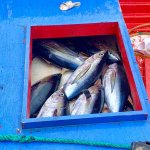


Interdisciplinary, international partnership formed to address marine pollution in the Marshall Islands
May 31, 2020
Project Contacts: University of Hawaiʻi: Dr. Megan Donahue (donahuem@hawaii.edu); Marshall Islands Liaison, Sea Grant: Max Sudnovsky (msudnovsky@cmi.edu); Press Contact, Sea Grant: Cindy Knapman (lknapman@hawaii.edu, 808-387-7634)
(Honolulu, HI) – An interdisciplinary research team from Hawaiʻi and the Republic of the Marshall Islands is starting a new project to measure the amounts of toxins in fish and pollution in the sediments and waters of the Marshall Islands.
The team will determine whether there are risks to human health in the waters where people live and play, and will make recommendations to address them. Members come from the University of Hawai‘i (UH), the Hawaiʻi Sea Grant College Program, several Marshall Islands governmental agencies, and the World Bank.
“Marine pollution is a problem that affects communities worldwide,” said Dr. Catherine Pirkle, associate professor in the Office of Public Health Studies at UH. “Toxins like mercury and PCBs are found in fish including swordfish and tuna, and studies show that small plastic particles are everywhere in our oceans, including in the fish we eat.”
The Pacific region is home to many diverse peoples who depend on the marine environment for their jobs, food, and recreation. In the Marshall Islands, fishing is an integral part of the culture and economy. And although there are limited sources of pollution nearby, local fish can become contaminated from toxins produced far away that persist in the environment.
The project began because the Marshall Islands government is concerned about marine pollution and wanted to prioritize understanding whether their citizens can eat local fish and swim in their waters safely. Working together with Max Sudnovsky, the Hawaiʻi Sea Grant extension agent based at the College of the Marshall Islands, the project PIs, Dr. Megan Donahue (School of Ocean Earth Science and Technology) and Dr. Catherine Pirkle (Office of Public Health Studies), along with post-doctoral researchers Drs. Rachel Dacks, Jonathan Whitney, and Eileen Nalley are combining their expertise to work with partners in the Marshall Islands to answer these important questions. The Marshall Islands Marine Resources Authority, Ministry of Health and Human Services, and the Environmental Protection Agency are working closely with the research team from Hawaiʻi. Together, they want to address marine pollution in the Marshall Islands and to promote human health.
“This is an exciting project that brings together many different partners to integrate water quality, fish and sediment contamination, and consumption data so that we can comprehensively consider the human health risks associated with marine pollution throughout the Marshall Islands,” Dr. Donahue said.
This project will generate valuable data that will aid in the management of sustainable, healthy fisheries and communities. It is also aligned with other ongoing Hawaiʻi based projects, such as the Pacific Regional Integrated Sciences and Assessment program and the Pacific Islands Ocean Observing System. This collaborative partnership continues to strengthen the relationship between the UH research community and colleagues in the Marshall Islands, while providing a framework for enhanced ecosystem-based management, adaptation, and education in the Pacific region.
The University of Hawaiʻi Sea Grant College Program is part of the University of Hawai‘i at Mānoa’s prestigious School of Ocean and Earth Science and Technology. It supports an innovative program of research, education and extension services directed to the improved understanding and stewardship of coastal and marine resources of the state, region and nation. Science serving Hawai‘i and the Pacific since 1968.

